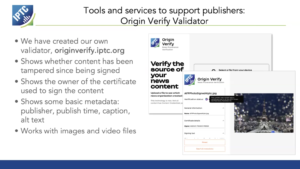Categories
Archives

Brendan Quinn of IPTC presented alongside Leonard Rosenthol of C2PA at the World-Wide Web Consortium (W3C)’s Authentic Web workshop series this week.
This was the second in a series of online workshops run by the W3C in an effort to bring together the various work on trust, provenance, credibility and authenticity. The first part of the Authentic Web workshop was run in March 2025.
Leonard presented C2PA, its motivations and work done so far, including describing how C2PA technology is currently used by platforms such as LinkedIn and TikTok, and by most generative AI tools to signal AI-generated content.
Then Brendan went on to describe how the IPTC’s Media Provenance Committee has established the Verified News Publisher programme, an industry specific “trust list” of media organisations who are using C2PA certificates to sign their published content.
W3C events mostly run in the open, so the session agenda, pre-read material, minutes and even a video recording of the presentation part of the workshop are all available online, even to non-members. As per W3C policy, the discussion portion of the event was not recorded. This allows for more open discussion.
Present at the workshop were representatives of Google Chrome and Mozilla, the W3C’s Technical Architecture Group (TAG), hardware and software vendors, and others with an interest in the idea of implementing content provenance solutions in their tools.
Depending on the outcome of discussions within the group and at further workshops, this work may lead to a physical meeting later this year.